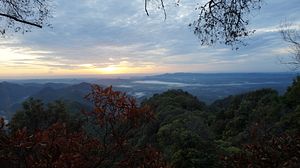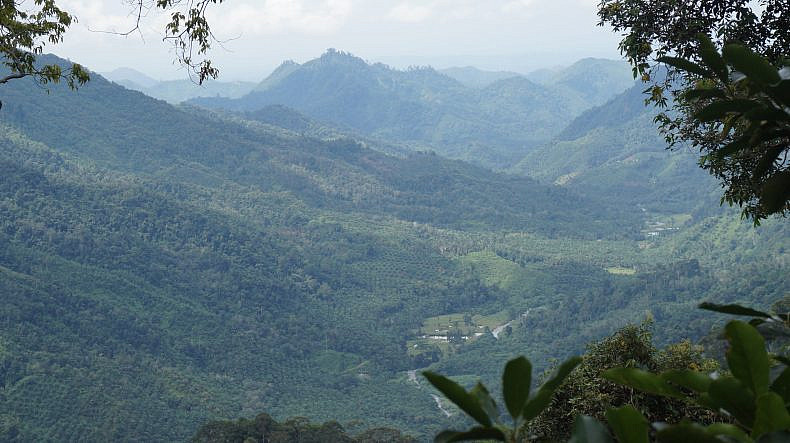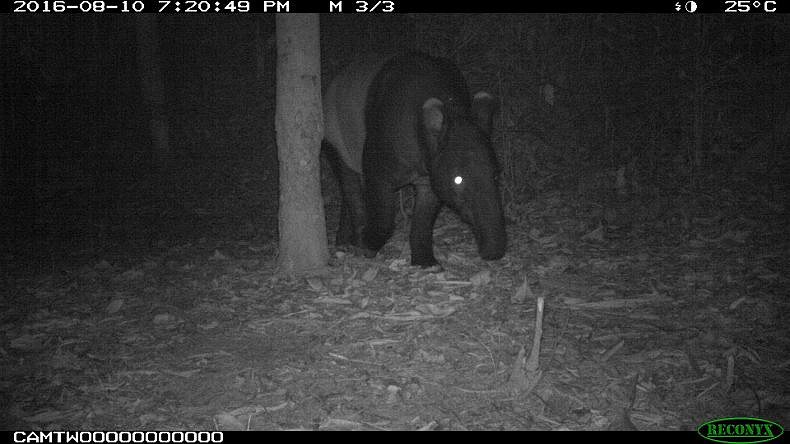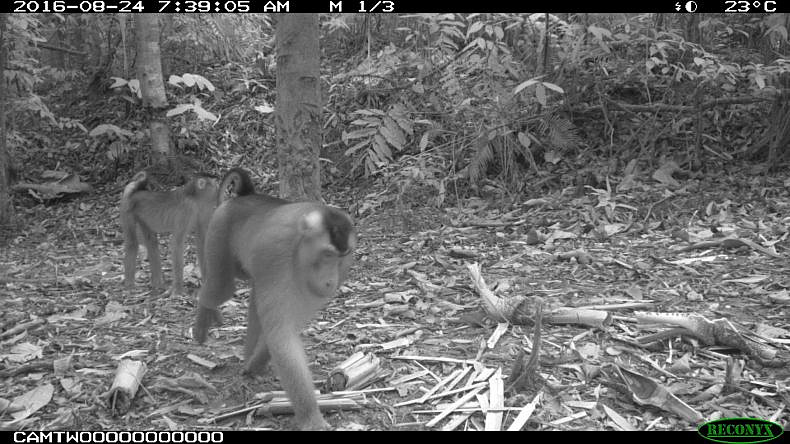If you were a crested serpent eagle riding the high air thermals, gliding a mile above the Rantau Prabat district of North Sumatra province on the island of Sumatra, the area that is locally known as the Hadabuan Hills would look something like a giant green octopus swimming through an ocean of palm oil plantations. The neatly ordered palm trees might also appear something like a strange jungle-themed quilt, but in the middle of it all rises a cluster of twisted mountain ridges that are too steep for plantations, and as a result, are still covered in the evergreen rain forest that once carpeted the entire island.
The lowland forests of Sumatra have been annihilated, and nowhere is that more apparent than in Rantau Prabat, a district that sees absolutely no tourists. It was as if some giant hand reached down from the heavens and poured a bottle of carbolic acid over the entire eastern plains. Gone. The forests replaced mostly by palm oil, with the occasional rubber plantation in the mix.
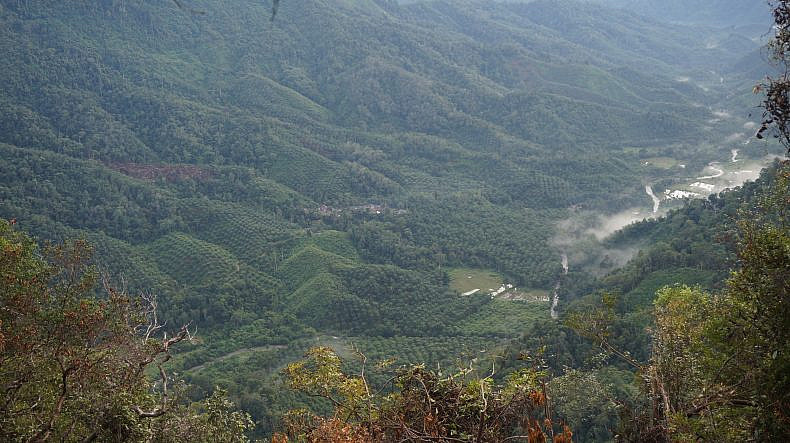
The lower sections of Hadabuan Hills, which have been converted to palm oil plantations. Image by Gregory McCann
But I had expected that. In fact, this was my second trip to Sumatra, and even seven hours in a car through plantations didn’t dampen my enthusiasm. I came for the gibbons and hornbills, and possibly a tiger or tapir.
When we finally passed the last strangely beautiful palm oil tree and cut the engine of our 4×4, the first thing we heard were siamang gibbons shouting in hills. They were like a jungle welcoming committee, calling out, crying, going ape for the sheer joy of it. And one should remember that gibbons are not monkeys but apes – the smallest of all the ape species. Of all species of gibbons, siamangs are the largest and the loudest, and they have been described coordinating to oust orangutans from fruiting trees in Gunung Leuser National Park to the north. You might say that siamangs are the kings of all gibbons. They are listed by the International Union for Conservation of Nature (IUCN) as endangered.
When siamangs take in a breath to pump their lungs before belting out the most bizarre of all of nature’s serenades, a large pouch forms on their neck, swelling up like a water balloon. Then all the other thousands of denizens of the forests brace themselves as a manic chorus of eardrum-shaking wails resounds from mountain to mountain and tree to tree. I was told later that siamangs – which Sumatrans refer to as “black gibbons” – sing to call the rain so that they can drink water caught in the upper reaches of the canopy rather than come down to the ground and risk being eaten by a tiger. It rained buckets a few hours after we first heard their calls.
Siamangs are not the only rare wildlife to find a home here. There are said to around 15 Sumatran tigers, listed by the IUCN as critically endangered, in the Hadabuan Hills. Five camera traps were donated to our host and jungle guide, Mr. Haray Sampurna Munthe, founder of a local NGO called Sumatran Tiger Rangers, and with those cameras he has recorded several tigers. The tigers that hang on in the rugged fastness of these hills, however many there may actually be, are not part of the national census and the protection of this undocumented group could go a long way toward helping the Sumatran tiger sub-species survive (Indonesia once had tigers in Bali and Java but those subspecies are now extinct).
Sumatran tigers, which are the smallest of all current tiger species, have distinctive white beards and penetrating eyes. They will eat just about anything, including gibbons and monkeys, if they get the chance – so I was told. According to locals who have spent years in the forest, the hunt goes something like this: the tiger spots a primate in a tree and stares at it. Tigers “have magic in their eyes,” and if the monkey or gibbon makes the mistake of making eye contact with the great cat, the tree-dweller will become entranced and soon fall out of the tree, becoming an easy meal for harimau, or tiger. The other method is cruder: harimau spots a monkey in a tree, stands up on his hind legs with his front paws holding the tree trunk, glowers menacingly skyward, and roars at the top of his lungs. The primate panics or simply faints, and falls down into the jaws of the true king of the jungle.
Haray told us not to worry during our four days in the forest, because tigers never hunt people. Jim Corbett, the famous hunter-turned-conservationist in British India, remarked that the tiger is a “big-hearted gentleman.” I once heard a tiger roaring in the pitch-black jungle night in Thailand just 100 meters away and I didn’t feel threatened at all. Maybe it was a love call to another tiger.
One more thing that tigers eat is durians. The big, spiky, smelly king of fruits falls ripe from a tree and harimau finds it laying on the forest floor. She uses her powerful claws to pry the thorny husk open and then licks up the exquisite custard-like flesh, savoring, I imagine, every last creamy drop. I’ve heard it said that wild durians don’t smell bad at all. We brought some durian trees to plant in the Hadabuan Hills so that harimau could be assured of many sweet-smelling meals in the future.
As we began our trek up into the mountains, rhinoceros hornbills honked in flight, their calls descending into primal growls and grunts as they landed on their aeries. Gibbons and hornbills are both signs of a healthy forest, as both species need large trees and relatively intact forest cover to propagate. It took less than an hour to reach the mountain ridge on which we would camp, which included a bamboo tree platform about 30 feet off the ground.
I did not like the looks of the rickety split-log ladder but up I went, assured that stupendous views awaited me. I was not disappointed. A patchwork of palm oil, rubber, and secondary forest lay silent in an early blue evening mist. It was a sublime scene, and it had me wondering if palm oil plantations and natural forests could co-exist side by side, monoculture and riotous life, agriculture and ecotourism.
I had seen something like this in Khao Luang National Park in southern Thailand, where a robust agricultural community existed alongside an interesting ecotourism program in Ban Khiriwong village in Nakhon Si Thammarat province. One key difference was that the local Thais of that area practiced polyculture farming, or mixed crop plantations—no single crop monocultures. The result was that you could walk through a “plantation” of durian, jackfruit, banana, mango, tamarind, coffee, and fig trees (among many others) and almost feel like you were in a natural forest. Another advantage of polycropping is that farms with numerous types of crops on each plot can withstand heavy rains and typhoons because there is a varied root system in place; the higher trees can provide shade from the sun or protection from strong winds so that erosion does not become a serious problem. Furthermore, mixed agriculture is also a hedge against diseases such as fungus, which might wipe out an entire crop. Wildlife also prefers the jungle-like polycrop plantations.
Nothing like that is to be found in Sumatra, with its endless rows of palm oil and rubber trees. The Hadabuan Hills, however, still has tigers, while Khao Luang has lost all its great cats (side note: both ecosystems still have Malayan tapirs). In addition to tigers, Haray’s camera traps have turned up: sun bears (one was recently video-recorded with a snare around its neck; it had sniffed the ground and a snare closed over its head and around its neck, and yet it was still alive), Malayan tapirs, binturong, golden cat, clouded leopard, barking deer, and much more.
We trekked for four days in the Hadabuan Hills, looking for places to set up camera traps. The mountain ridges form natural wildlife trails of tall trees and little underbrush. This is characteristic of old growth forests and it was a sign that the high mountains themselves suffer little disturbance – yet. Argus pheasants called throughout the day, their loud, ringing wow woooow calls mixing into an organic medley with the cries of siamang gibbons and white-handed gibbons above them in the canopy, and with the honks, growls and cackles of rhinoceros and oriental pied hornbills. Claw marks from sun bears were apparent on many trees, and there was a footprint beside one creek where we stopped to refill our water bottles. Was that a tiger pugmark? It was difficult to say with the daily rain washing away any details.
On the last day we decided on a “shortcut” straight down the side of a mountain, attempting to cover three days in one by this route. In one hidden valley crammed back among the crags we came upon a family of white-handed gibbons, who went silent upon our arrival and brachiated away to safety. From the same area, two rhinoceros hornbills made an inexplicably straight dash out of a secret perch. Being on a high, steep slope, we were almost eye-level with them. It was a vision of paradise: two huge black birds darting over the jungle canopy, their huge white-yellow beaks crowned with a red upturned “horn.” We were close enough that I could see the red of the male’s irises, and the white of the female’s.
Hornbill hunting is epidemic in Sumatra, and Haray said that outsiders come from far away in search of the “king hornbill,” the largest and most spectacular of them all, also known as the helmeted hornbill. Chinese buyers are driving a horrid poaching crisis in Sumatra and Borneo where hunters go into forests and shoot any and all hornbills in the hopes that some are helmeted hornbills so that their “red ivory” (it’s not actually ivory but keratin, the same substance found in a human fingernail) can be carved into trinkets.
How long can this unknown (to outsiders) ecosystem hang on? Farmers are encroaching on the remaining forest, and month by month the palm oil creeps farther and farther up the hillsides. Can the farmers learn the value of the high mountains as watersheds for their crops? Can they learn to not retaliate against the tapirs and macaques that sometimes raid their farms for seeds and fruits? Can they have confidence in an ecotourism program that might bring them income if the wildlife remains? Will an international NGO swoop down and save the day for the Hadabuan Hills and its enigmatic fauna? Or is it all just a lost cause?
At the turn of the 20th century, a young Hungarian man named Ladislao Székely traveled to Sumatra in search of work on the burgeoning tobacco plantations of the era. Rubber was also making massive inroads into the virgin Sumatran lowland jungle of the east coast at that time. He had a hand in it all, and often made notes about the gibbons singing at the fringe of the forest. On the last page of his book Tropic Fever: The Adventures of a Planter in Sumatra (1937) he reflects:
“But under the scorching equatorial sun life pulsates at fever-heat. Out of one life springs another, out of the old, the new. Worlds, century-old worlds, vanish in a day, and in a day a new world will blossom in its place. For everything moves fast on the Equator.”
True words. Who can deny them? But does it all have to vanish? All of the old? Every last bit of it? It has already happened with Sumatra’s lowland forests. Annihilated, vanished, and the millions of animals that lived there gone forever. Can there be a change of heart in the local people, in the government? Can there be a change in the way local people view this last holdout for wildlife in Rantau Prabat? Or will Székely’s words prove prophetic for the Hadabuan Hills as well?
I hope that somehow, someway, in five years’ time, in one or two decades from now, if a crested serpent eagle was riding the high thermals, coasting on the air currents high above Rantau Prabat, that if he looked down he would still see a giant green octopus swimming across the landscape, and that he might notice other things as well: ecotourists hopping out of their rickety 4x4s like we did, and being guided up to the tree house by a local team getting paid for the job. He might also spy harimau using his magic eyes to entrance a gibbon to fall from the safety of his high perch, or he might see the same great cat slurping up some creamy durian fruit from a tree that we planted. Hopefully he’ll see pairs of rhinoceros hornbills like I did, whooshing from one side of a valley to the other, and I really hope our eagle would see the helmeted hornbill landing on a perch, feeding its mate and its young, and letting out its haunting, mocking cackle to resonate across the tree crowns.
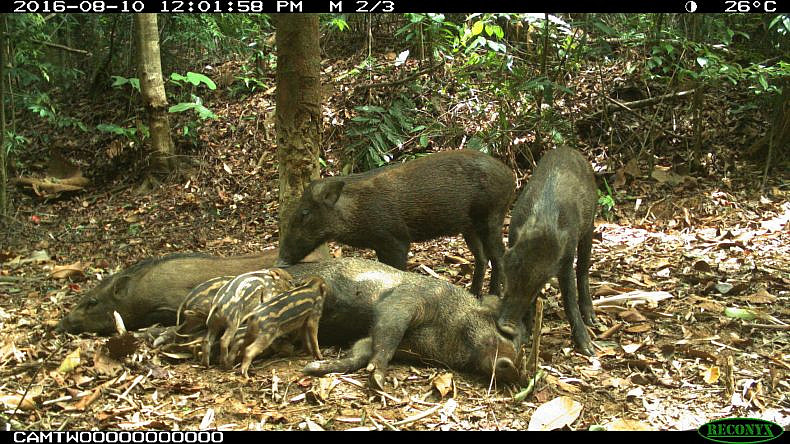
A family of wild pigs stops for a rest in front of a camera trap in the Hadabuan Hills. Image courtesy of Gregory McCann.
For wildlife such as Sumatran tigers, Malayan tapirs, sun bears, siamang gibbons, Argus pheasants, and five types of hornbills, there is a struggle for survival going on in a forgotten corner of Sumatra (there are other such spots on this island as well). Why don’t more people care to seek out these forgotten mountains, these overlooked nooks of biodiversity? We’ll search for rare Pokemon characters but not the endangered wildlife of Southeast Asia. Haray and his team of Sumatran Tiger Rangers need help, and fast, from local people, the government, from ecotourists, and anyone who is drawn to places like this.
Gregory McCann is the Project Coordinator for Habitat ID and the author of the book Called Away by a Mountain Spirit.













